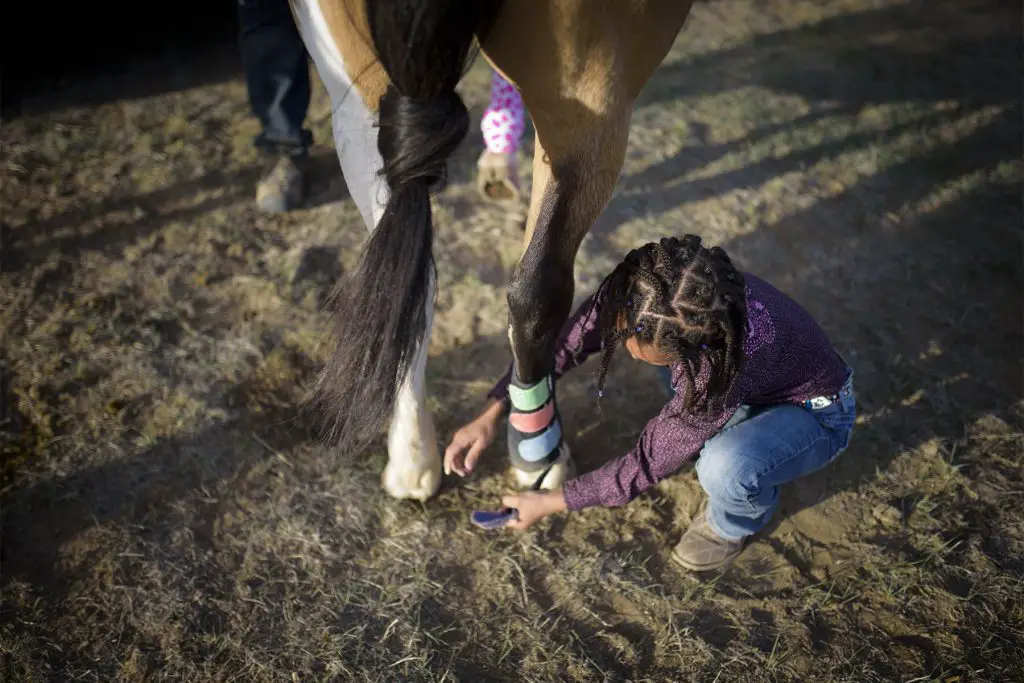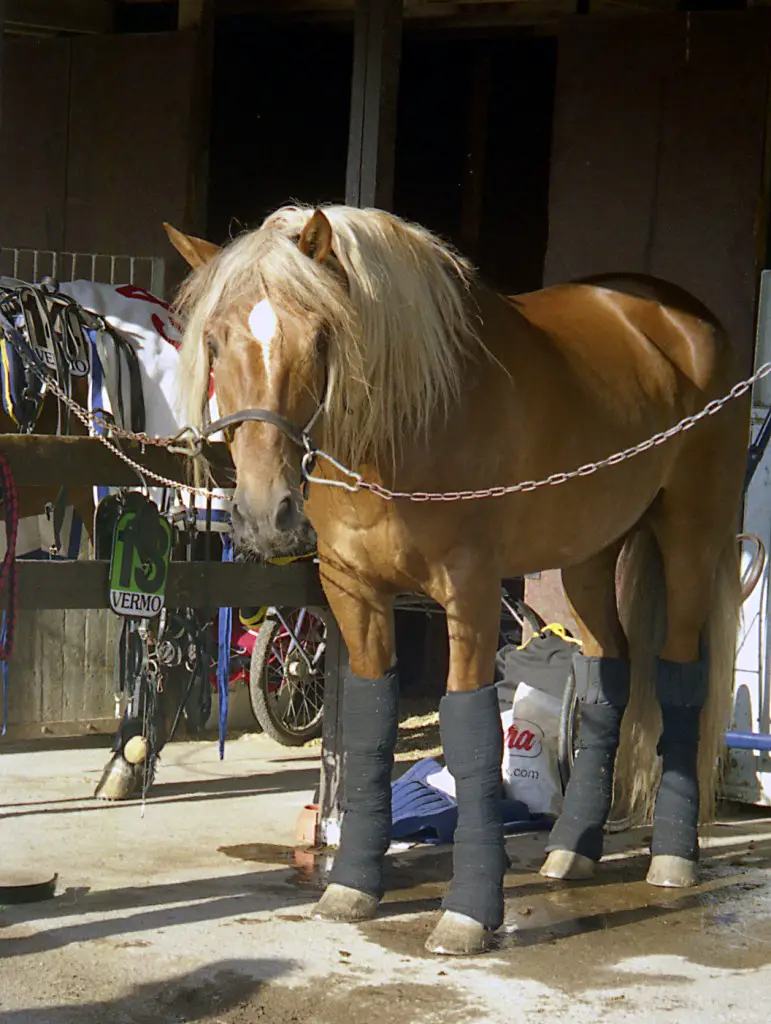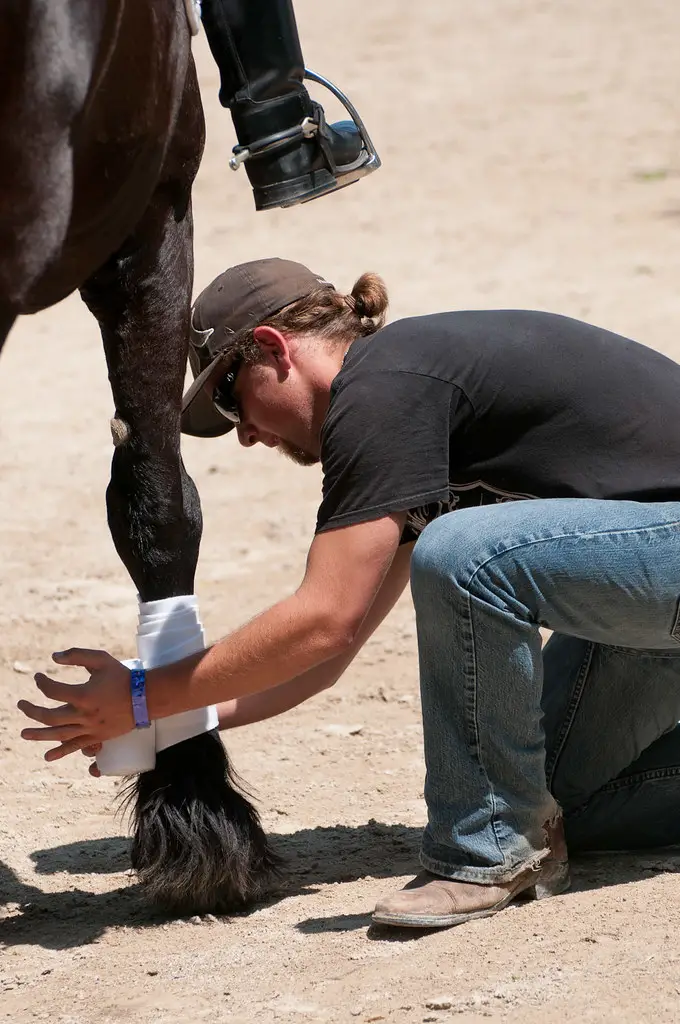Last Updated on July 13, 2020 by Allison Price
Have you watched horse racing? You will see some horses race with their legs wrapped and other running without. Do you ever wonder why trainers wrap race horses’ legs? The purpose of leg wraps is to protect horses’ legs from rundown abrasion. Also, from interference injury. Leg wraps also provide support for the horses’ legs. Sometimes they are used because they look good. Racehorses wear leg wraps for a variety of reasons. We will go through each of them in this article.
Leg Wraps Are Optional in a Horse Race
Racehorses run with wraps on their front legs, rear legs, all legs or no wraps at all. But it does not tell the condition of the horse. It’s typically a choice the trainer makes based on his experience. Some trainers run every horse under their care in rear wraps. Others don’t like to have anything on their horses’ legs unless necessary.
Rundown Bandages
Wraps on horses’ hind legs are the most common and are known “rundown bandages.” These are used to prevent friction abrasions and interference injury. Rundown abrasions occur during a race. It is when horses go down on the back of their fetlock area, hit the ground and create friction. Horses racing in deep tracks and with long pastern are vulnerable rundown abrasions. To prevent this, special pads made of felt are used to cover the rear fetlock area. The pads are held in place using vet wrap, a stretchy and self-adherent bandage.
Rear legs are wrapped to protect them from speedy cutting and scalping.
Speedy-cutting and Scalping
Speedy-cuts occur when the foot of the front leg hits the rear leg typical close to the knee of hock. Speedy-cuts happen when horses are running hard and are often severe. Because the horse’s shoe toe acts like a knife against the soft tissues of the contacted leg. These can result in severe lacerations and tendon damage. Scalping is often used interchangeably with speedy-cuts. But it should be limited to the contact of the forefoot with the coronet band of the hind limb.
Leg Wraps Protect from Injuries

The front legs of a racehorse are wrapped to protect from interference and injuries. Also, to provide tendon support. When one of the horse’s limbs comes in contact with another limb can cause interference injury. Horses’ legs hit for a variety of reasons. Some of these reasons are conformation, poor fitness, improper shoeing. The mechanics of the horse’s stride is also one of the reasons. A healthy horse could misstep during a race and strike its legs against each other. And can still cause an injury.
Interference Injuries
How severe the interference injury can range from rubbed hair to a deep cut. Interference injury causes bruising, pain, and swelling, particularly in the fetlock joint area.
Brushing
It is an interference injury that occurs when the opposite limbs contact each other. In front limbs, the contact commonly arises from the knee to the hoof. In the rear legs, the strike is usually in the fetlock area. The interference tends to increase with the variation of the horse’s turnover rate. Although some horses contact decreases at higher speeds. So, there is not a direct correlation to higher speeds and increased strikes.
Overreaching
Overreaching happens when the toe of the rear foot strikes the lower back of the front limb. A strike in this area may result to a severe injury and downtime for the racehorse. Oftentimes, an overreach injury tears the bulb of the heel or catches the rear of the front foot’s shoe. Bruising and scraping usually occurs on the lower limb and can be minor or severe.
Forging
Forging injuries cannot be protected by bandages. But it is a type of an interference injury. It occurs when the rear toe strikes the sole of the front foot. It usually happens right after the front foot leaves the ground.
Benefits of Using Polo Wraps

Polo wraps are bandages wrapped around the horse’s legs. Having your horse wear them is beneficial in many situation. Your horse can use this during turnout, schooling, and horse shows. A lot of horse owners love polo wraps because they are inexpensive, machine washable and easy to use. We have listed the benefits of using leg wraps:
Protection
Polo wraps protect the canon bone region, as well as the tendons and ligaments in that area. Horses that play rough often step on each other and get tangled up in one another’s legs. With that, lacerations and bruises can occur if they are not wearing protection. Wraps offer a decent padded barrier to protect the leg from these insults. Not only does it protect a horse from other horses but it also protects a horse from itself. Forging, cross-firing, and striking can lead to splints and bucked shins. Polo wraps are inexpensive way to help stop this collateral damage.
Support
Polo wraps hold the ligaments and tendons in place and in proper alignment on the leg. It helps prevent injury during strenuous workouts. And while a horse is developing his strength during training sessions. They protect the tendons from overstretching as well. This is useful especially when horses must make sudden turns or shifts in movement.
Training
During training sessions, polo wraps protect and support the horse’s legs. It also helps for the rider when horses wear leg wraps. Indoor arenas have mirrors on the walls so that riders can check their position. It is easier to see his leg position during schooling if you use brightly colored polo wraps on your horse’s legs. Brightly colored wraps can also be used during lunging to make the legs easier to see.
Appearance
Many riders love the way polo wraps look. White wraps are sometimes used on all four legs of a dressage horse. It can make its movements appear symmetrical and balanced. Some horse owners used bright neon orange wraps during hunting season. This is to prevent hunting accidents. This is useful on dun-colored horses.
Polo Wraps are Versatile
Wraps are stretchy and conform nicely to a horse’s leg which allows them to stay on during movement.
Takeaway
Basically, leg wraps provide protection and support during horse racing. Not only that, it makes the horses look good. Trainers go all out to make their horses look special. They use stylish braiding and colorful wraps to enhance the appearance of the horse. But you need to be careful. Wrapped legs annoy some horses and if not applied correctly, can come loose during a race.


